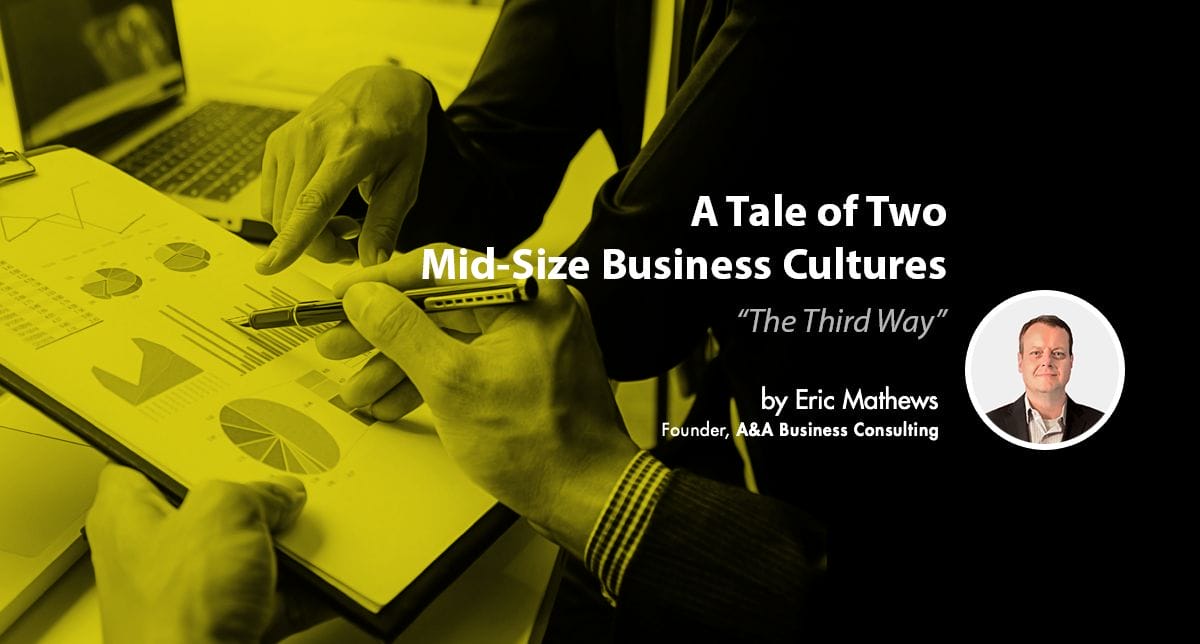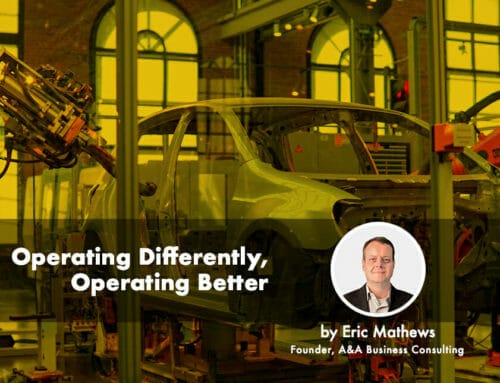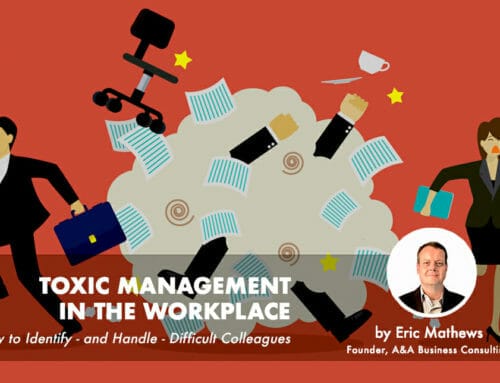There was once a mid-size company in which the management directed every decision. They hoped this would drive the employees on a singular course. Though the organization had many hands at work, there was only one corporate brain directing all the activity. Creativity and personal investment were liabilities the organization felt they could not afford. As a result, productivity never reached its full potential; for how could they get the best out employees who were stuck in an overmanaged role? And personal responsibility was shirked; for who was really to blame when the corporate brain managed all?
Across town, there was another mid-size company. In this business, employees worked on self-directed teams, released to follow the whims of their daily tasks and goals. Here, there were many hands at work, all pulling in different directions. The employees never knew if they had fulfilled the goals or vision of the organization, and this made them anxious. As a result, groups began to overpower individuals; for when the future is uncertain, there is safety in numbers, right? And employees never hit the intended targets; for how can a person hit a target that hasn’t been clearly pointed out to them?
Each of these two organizations suffered from the extremes of corporate culture. The first operated in the familiar top-down management model. The second used the more recent self-directed work culture model. But both these extremes of corporate culture failed to meet goals, failed to bring the best out of each individual employee, and failed to maximize resources. Any of these culture failures could kill a mid-size business.
In contrast, I’d like to offer you another option:
The Third Way
A healthy mid-size organization looks for that perfect balance between top-down and self-directed work cultures. Employees are empowered to communicate across levels of hierarchy and released to creatively implement their ideas. They receive consistent expectations and feedback, and leadership provides clear communication and coaching.
So, what do you, the leader, need to do in order to cultivate this healthy mid-size business culture? To begin with, you need to be emotionally intelligent—not telling others what to do but guiding them always towards the company vision. You problem solve with people, not for them. Because of this, middle managers are often the strongest, most influential managers within a mid-size business. Their understanding of lower managers and supervisors enables them to coach instead of command.
A self-directed work model is often praised as the ideal, though in life, it rarely works out as well as we would hope. Even in the best-case scenarios, this model is non-replicable. Ender’s Game, one of my favorite books, details the leadership style of “Ender” Wiggin. Though he succeeds in releasing his team to act with hardly any supervision, all other teams fail using this model. One could argue that his team only succeeded under this model because Ender had coached and trained each of his team members from the beginning—an option few managers enjoy in real life.
The Third Way still empowers employees and trusts their insight but provides boundaries and guidelines that will reassure staff and hold them accountable. Every person in the company should know the vision and the mission of the organization, and whether or not it’s being accomplished. They should also know the short- and long-term objectives of their team or department and the plan to reach those objectives. And finally, they should have someone holding them responsible for their participation in the company’s greater efforts.
Unique Culture Challenges and Solutions for Mid-Size Businesses
Let’s look at what makes mid-size corporate cultures different than the cultures you’d find in large or small businesses. Unlike other companies, mid-size businesses don’t have the same cash power. They have less of the organic personalization of smaller businesses but cannot afford the culture-building spaces and practices of much larger companies. Without the familiar intimacy of mom-and-pop shops or the opulent staff facilities of Amazon or Google, mid-size companies must navigate their growing culture while maintaining a strict hold on their wallet.
Chances are, you already have ideas about how to address some culture problems, but you don’t have the money to do it. The staff also sees these problems and can resent the higher-ups for not making those much-needed improvements. In mid-size companies, people problems tend to linger longer because the necessary changes would hit the bottom line harder than in small or large businesses.
So, you need creative, cost-conscious solutions to culture problems. Here are just a few ideas you can implement today:
- Listen to employees and respond
Listening only costs the time you invest in the practice, and the payoff is always worth it. The larger the organization, the more the top can get disconnected from the bottom. At a mid-size organization, there’s just enough space for messages to get lost or miscommunicated. While I write more about this in a previous post, I’ll say that finding and creating space for listening is vital for sustaining a healthy business culture.
Heifetz and Linsky write in their book, Leadership on the Line: Staying Alive through the Dangers of Leading: “As social workers say, ‘Start where people are at.’ Beyond the capacity to listen, this requires curiosity, especially when you think you already know someone’s problem and what needs to be done. Their view is likely to be different from yours, and if you don’t take their perspective as the starting point, you are liable to be dismissed as irrelevant, insensitive, or presumptuous.”
In addition to curiosity, active listening also requires a response. After taking in new thoughts, concerns, worries, and hopes, what can you do immediately to indicate that you’ve heard your employees and that you care about their perspective? Maybe you can’t fulfill all their needs right now, but is there a small gesture you can make, a first step you can take?
Let me give you an example. An employee complains that the lunchroom is a dismal dungeon of doom (OK, maybe not in those exact words, but something to that effect). Perhaps you can’t afford a complete overhaul of the space, but a few gallons of paint can brighten up and refresh a room. Or new coffee maker can show your appreciation (plus give everyone a little afternoon energy boost). To you, it’s just a lunch room. To your employees, it’s a symbol of how you see them. Are they real people to you, or just resources to be used up?
- Understand what’s driving the culture
It’s impossible to take ownership of a company’s culture if you don’t know what it is. Though the top is responsible for crafting and driving the culture, they’re not always close enough to know how their decisions affect all others. It takes deliberate and purposeful effort on the part of the leader to understand the factors generating culture.
To accomplish this, Heifetz and Linsky advise: “The only way you can gain both a clearer view of reality and some perspective on the bigger picture is by distancing yourself from the fray. Otherwise, you are likely to misperceive the situation and make the wrong diagnosis, leading you to misguided decisions about whether and how to intervene.”
As you gain that healthy distance and perspective, here are some questions to ask yourself as you investigate your business culture:
Which staff members are exerting the most influence? (More on that below.)
In which direction does the staff believe the company is heading?
What fears are influencing employees? Fear of failure? Of reprimand? Of the company’s financial instability?
How have changes in management affected the morale?
Is the company’s vision consistent? Or does it fluctuate with external pressures?
How stretched are the resources? Who is feeling that leanness the most? Which department, which team, which employees?
Finally, is there a disconnect between vision, goals and day-to-day activities?
Though these questions won’t provide you with a complete analysis, they will help guide you as you examine the factors shaping your company’s culture.
- Promote the right people, attitudes, and ideas
You want to empower people within your company, but it’s equally important to make sure you’re empowering and promoting the right people, attitudes, and ideas. In a mid-size business, meeting deadlines is vital to better cash flow and growth potential, and this is only possible with high employee retention. The more staff turnover, especially of your key players, the harder it will hit your bottom line.
And yet, keeping the wrong people will kill the culture and force out those key players you’d love to retain. In my experience, when culture is heading the wrong way, it’s not the good people who stay and the bad people who leave. It’s the opposite—usually, the toxic people stick around a lot longer than the good people do.
As for those you do retain, their attitudes and productivity will be impacted by negative or toxic coworkers. I had a client a few years ago who observed that within most companies 30% of a workforce comprised of “good workers,” who would carry on despite external circumstances. 20% were toxic and would likely remain that way. The final 50% were the workers who could be swayed in either direction, depending on the choices you make as a leader. The behaviors and people you promote are the behaviors and people that will have the most influence on the culture and the other employees.
Now, some may hesitate before making that final decision to get rid of toxicity, worried that firing an employee—even a bad employee—will negatively impact the bottom line. But Harvard Business School conducted a study which showed that avoiding (or getting rid of) a toxic worker is better for your financial bottom line than even hiring a “superstar” employee. Finding that top 1% superstar employee (a costly and energy-consuming process) only saved the companies an average of $5,303; whereas, avoiding the toxic employee saved companies $12,498. So maybe you can’t afford to hire “superstar” employees—why not focus on avoiding and ridding yourself of the toxic ones? It will actually save you more money in the long run.
- Create consistent vision
Finally, it’s hard for your staff to feel good about their work output if they’re not sure how it lines up with the organization’s greater mission. They want to know that they are individually and collectively contributing to meeting the goals and vision of the company. Mid-size businesses with healthy corporate cultures are easy to identify: their employees are proud to work for them. And they are able to feel proud, because the vision is consistent and unwavering, clearly communicated and pursued together. Give the employees of your business something to feel good about, something to be proud of.
Believe it or not, in my time as a business consultant, I have actually come across a few mid-size companies I would describe as having a healthy organizational culture. In these companies, everyone was highly engaged at all levels of the organization, communication was strong, expectations were understood at all levels, and employees knew what they needed to do. Instead of falling into the extremes of either of the Two Businesses from the top, they found that Third Way right in the middle. If you’re unsure how to find that Third Way, I’d love to hear from you!





